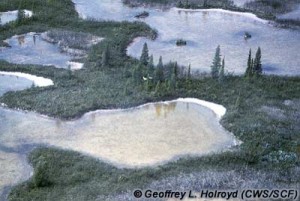by Canadian Wildlife Service
The 2012 whooping crane nesting season was again productive with a high number of nests being discovered and many fledged young observed. Water levels in spring and late summer were adequate and chicks benefited from mild summer conditions. For the third time since 1988, whooping crane chicks were captured and banded in Wood Buffalo National Park (WBNP). Annual precipitation preceding the 2012 breeding season was 14 percent below the 60year average despite above average accumulation in the spring. The majority of spring precipitation fell in the month of March before the arrival of cranes in WBNP. During May, water levels were high in most parts of the breeding range, giving the birds many options for nesting. Rain in July, August, and September maintained water levels and presumably supported an adequate food supply. Area affected by forest fires in WBNP was extensive in 2012. Six percent of the park burned in 2012 (the 25-year average burn area is 1%). Five fires occurred in the whooping crane nesting area, burning 17,312 ha or 4.2% of that area.
In May, aerial surveys were conducted to identify whooping crane breeding  pairs and nests in and outside of WBNP. During surveys, 67 pairs of whooping cranes were detected, 66 of these had nests. This number represents the third highest count on record. In addition to nests detected during surveys, three lone birds displaying territorial behaviour were observed but nests were not located for these birds. The single non-nesting territorial pair suggests potential for further population expansion in coming years. Of the 66 nests detected in 2012, five were in new territories (all within WBNP) and five were outside of the national park (two in the Lobstick Creek area, and three north of the Nyarling river).
pairs and nests in and outside of WBNP. During surveys, 67 pairs of whooping cranes were detected, 66 of these had nests. This number represents the third highest count on record. In addition to nests detected during surveys, three lone birds displaying territorial behaviour were observed but nests were not located for these birds. The single non-nesting territorial pair suggests potential for further population expansion in coming years. Of the 66 nests detected in 2012, five were in new territories (all within WBNP) and five were outside of the national park (two in the Lobstick Creek area, and three north of the Nyarling river).
In late July, surveys to determine fledging success of whooping cranes were completed. In total, observers detected 35 fledged young in 33 family groups (31 groups had a single chick, two families had two chicks). Apparent average fledging success was slightly higher (0.53) than the 20-year average (0.48). Actual success may have been higher but smoke from fires during surveys made it difficult or impossible to access several territories in which nests were detected earlier in the year; thus, additional chicks may have fledged but gone undetected.

The nesting habitat of the Whooping Crane consists of marshes, shallow ponds, small creeks, and patches of wooded terrain and shrubs. Note two whooping cranes in the center of the photograph
This year marked the third year of a multi-agency research initiative to capture and mark fledged whooping crane chicks in WBNP. Captured birds are fitted with a satellite transmitter with Global Positioning System capabilities mounted on a two-piece leg band. Transmitters are programmed to record the bird’s spatial location four times daily, recording both daytime and nighttime locations; this schedule provides data on diurnal and nocturnal (roosting) habitat use during all stages of the annual cycle, and on migratory behaviour in spring and fall.
The marking project, carried out by the Whooping Crane Tracking Partnership (WCTP), represents a cooperative effort between five core partners: the Canadian Wildlife Service, the US Geological Survey, the US Fish and Wildlife Service, the Crane Trust, and the Platte River Recovery Implementation Program (with support from Parks Canada Agency, the International Crane Foundation, and the Gulf Coast Bird Observatory). On 31 July and 01 August, 10 fledged whooping crane chicks were captured and marked with satellite transmitters.

